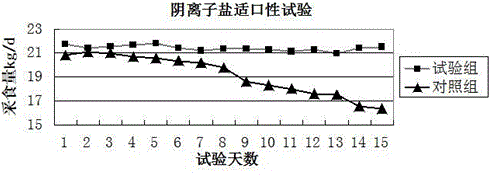Preparation method of anion salt with high palatability for cows
An anion and palatability technology, applied in application, animal feed, animal feed, etc., can solve the problems of low anion content and poor palatability, and achieve the effect of high utilization rate, high palatability, and avoidance of waste.
- Summary
- Abstract
- Description
- Claims
- Application Information
AI Technical Summary
Problems solved by technology
Method used
Image
Examples
Embodiment 1
[0022] Embodiment one: optimal component ratio test
[0023] The purpose of the test: to screen out the optimal combination of amino acid complexed magnesium, coated magnesium sulfate, coated ammonium chloride, fermented soybean meal or yeast, spores, and lactic acid fermented products among the various components of the present invention through comparative tests. Compare. Simultaneously evaluate the effect of adding the present invention on the palatability of cows and the pH value of cow urine.
[0024] Experimental animals: randomly select 60 dairy cows in the pre-perinatal period (21 days before delivery to delivery) and divide them into four groups according to the principle of similar weight, parity, and expected delivery date, which are three treatment groups and a control group, with 15 cows in each group .
[0025]Experimental treatment: the basic diets of the four groups were: corn silage (wet weight) 13kg / head·day, Leymus chinensis 4kg / head·day; concentrated feed...
Embodiment 2
[0032] The purpose of the test: to compare the palatability difference between the anion salt of the present invention and the traditional anion salt and its application effect.
[0033] Experimental animals and grouping: 80 dairy cows in the perinatal period (21 days before delivery to delivery) were randomly selected, and divided into experimental group and control group according to the principle of similar weight, parity, and expected date of delivery, with 40 cows in each group.
[0034] Test treatment: This test consists of two tests, one is a comparison test of the palatability of two anion salts, and the other is a comparison test of the use effect of two anion salts.
[0035] Test method: two kinds of anion salt palatability comparison test: the basic diet of the test group and the control group is the same, the traditional anion salt is added in the control group, and the anion salt of the present invention is added to the test group. In the two treatments, the amoun...
Embodiment 3
[0043] The purpose of the test: to test the effect of the product of the present invention on reducing the urine pH value of peripartum cows and controlling the rate of retained placenta.
[0044] Experimental animals: select the peripartum cows in the entire pasture as the experimental group, the control group is empty, and the data of the control group are the historical data of the retained placenta rate and midwifery rate data of the pasture. The test period was August, and the data of the control group were the average values of the 5, 6, and 7 months.
[0045] Test method: the perinatal cattle herd in this pasture is 21 days before delivery to the farrowing cattle herd, add the anion salt of the present invention in its diet, the addition amount is 175g / head·day, adjust the calcium content of the diet to 0.82%, and the rest Feeding and management methods are the same as the original method. The urine pH value of the perinatal cows was continuously measured 5 days befo...
PUM
 Login to view more
Login to view more Abstract
Description
Claims
Application Information
 Login to view more
Login to view more - R&D Engineer
- R&D Manager
- IP Professional
- Industry Leading Data Capabilities
- Powerful AI technology
- Patent DNA Extraction
Browse by: Latest US Patents, China's latest patents, Technical Efficacy Thesaurus, Application Domain, Technology Topic.
© 2024 PatSnap. All rights reserved.Legal|Privacy policy|Modern Slavery Act Transparency Statement|Sitemap


